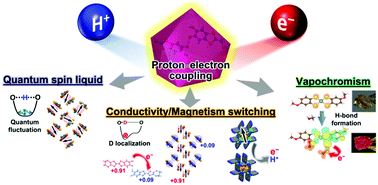Proton–electron-coupled functionalities of conductivity, magnetism, and optical properties in molecular crystals
Abstract
Proton–electron-coupled reactions, specifically proton-coupled electron transfer (PCET), in biological and chemical processes have been extensively investigated for use in a wide variety of applications, including energy conversion and storage. However, the exploration of the functionalities of the conductivity, magnetism, and dielectrics by proton–electron coupling in molecular materials is challenging. Dynamic and static proton–electron-coupled functionalities are to be expected. This feature article highlights the recent progress in the development of functionalities of dynamic proton–electron coupling in molecular materials. Herein, single-unit conductivity by self-doping, quantum spin liquid state coupled with quantum fluctuation of protons, switching of conductivity and magnetism triggered by the disorder–order transition of deuterons, and their external responses under pressure and in the presence of an electric field are introduced. In addition, as for the functionalities of proton–d/π-electron coupling in metal dithiolene complexes, magnetic switching with multiple PCET and vapochromism induced by electron transfer through hydrogen-bond (H-bond) formation is introduced experimentally and theoretically. We also outlined the basic and applied issues and potential challenges for development of proton–electron-coupled molecular materials, functionalities, and devices.



 Please wait while we load your content...
Please wait while we load your content...